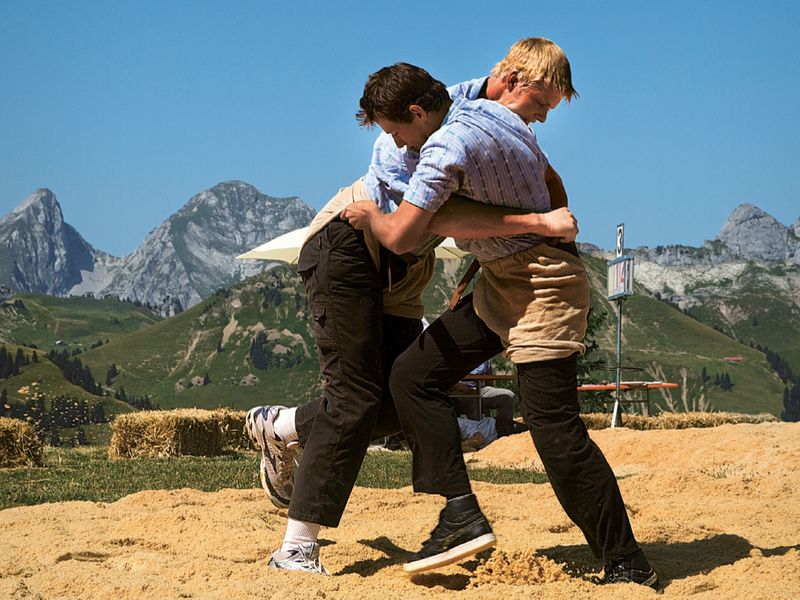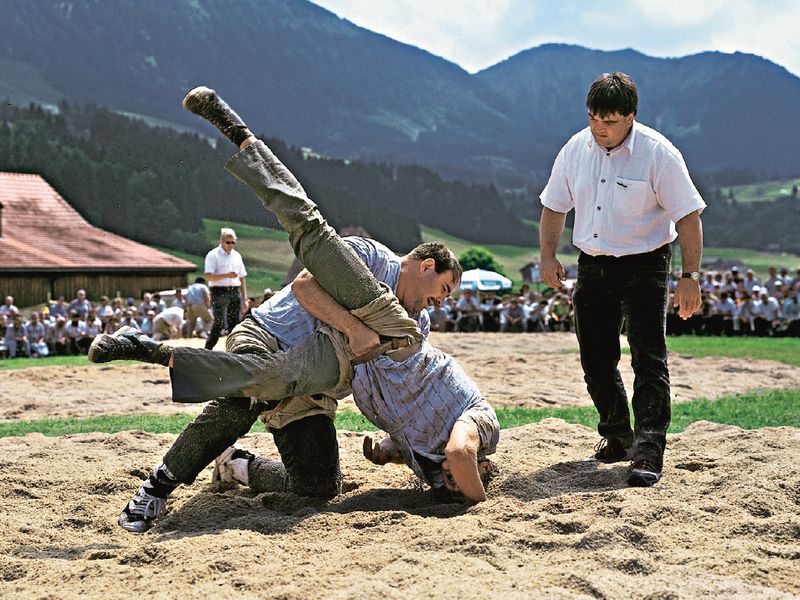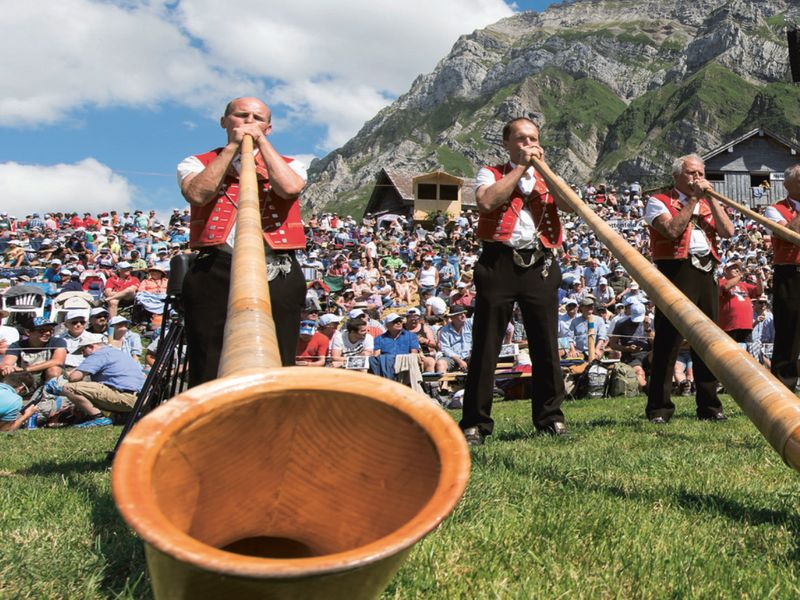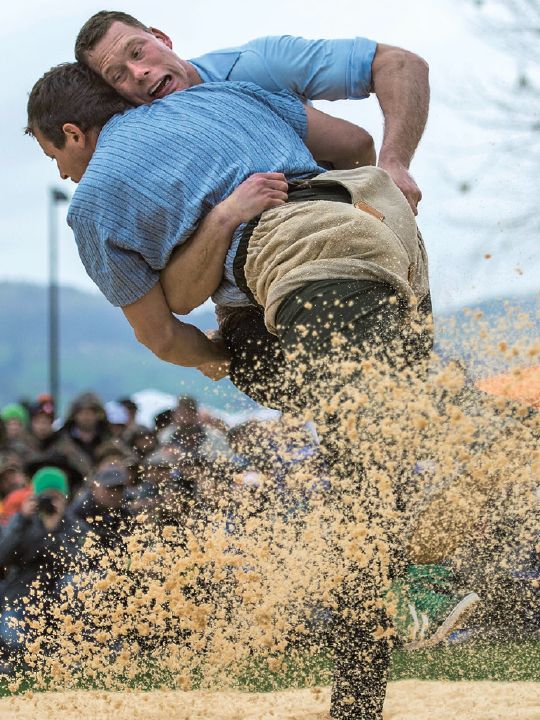
Highlight
Still a secret kept closely within its borders, Swiss wrestling is experiencing an astounding popularity at home. With its superstars, events and folklore, it is helping to define Swiss identity
“Matthias Sempach is unable to respond to your requests or invitations. His schedule is already full with interviews and photo-shoots.” This definitive email is how the agent of the most popular Swiss wrestler answered our enquiries. Unheard of elsewhere in the world, Sempach is a real superstar in the German-speaking part of the country. “He’s rather like the equivalent of Zidane in France”, Claire-Lise Rimaz from the Swiss Office of Tourism told us. It has to be said that for the Swiss, wrestling, “breeches lifting”, or Schwingen, is the number one national sport. When it comes to national sporting pride, the Swiss have Roger Federer and wrestling.
More a tradition than a sport
So much more than simply a sport, this ancestral practice, inherited from Alpine customs, gives rise to numerous competitions, events and celebrations that touch the very heart of the Swiss soul. “It’s a return to our roots, to our origins”, Matthias Glarner, one of the current stars of the discipline, explains. “It’s something truly traditional and cultural. Fights between two men also hold a certain fascination for the general public.” Tinged with patriotism, wrestling helps to strengthen the social and festive bond between the various inhabitants of this multilingual country, divided into 26 cantons. It is a perpetuation of a non-violent philosophy, one in which modesty and respect are primordial values, even if the clashes between wrestlers could quite easily make you believe otherwise. “It is a very popular sport here because you never see any brawls or aggressive behaviour during the events. The last national event at Estavayer-le-Lac, for example, attracted 280,000 spectators with not a single bad incident to report, whereas the final of the Swiss Football Cup in Geneva called for 600 additional policemen”, explains Ernest Schläfli, one of the French wrestlers who has won the most titles in history.
Wrestling actually draws massive crowds. Small village events including sports other than wrestling are also held regularly. At Estavayer-le-Lac, the Swiss Army is supervising the construction of the largest temporary arena in the world, where 275 wrestlers will come head-to-head. The event will take place over three days and the public can stay on-site (in tents or camper vans), eating at the “Place de fête”, a village covering 90 hectares with canteens, restaurants, a folklore hall and a VIP area.

As well as exalting national pride, something not altogether displeasing to the Swiss conservative party, the UDC, wrestling is a form of escape. A competition offers escapism and the opportunity to spend time “with other Swiss people”, but also to manage rivalry issues between the cantons. “Above all, it is very much about rivalry between the five regional wrestling associations that cover the territory”, Schläfli says.

Local clubs dispense theory and combat strategy, but it is at can-tonal level that “active” wrestlers – with a licence to do so – indulge in the pleasure of rolling around in sawdust. These amateurs wrestlers come from all walks of life, but roots in the Swiss countryside add extra authenticity to the combatants.
The Swiss masculine ideal
Wrestling often has a long family tradition, but as Ernest Schläfli can confirm, “It’s open to anyone with no discrimination whatsoever”. Harald Cropt can confirm this. With Swiss and Haitian parents, he represents the recent diversity that is changing this sport. Matthias Glarner and Ernest Schläfli also come from a long dynasty of wrestlers. “In my family, wrestling is a tradition”, Glarner confirms. “My grandfather did it, and so did my uncle and my cousin. So it a natural choice for me.” But if you want to practise this sport you really need to be strong and agile, with good reflexes — and train regularly. “Good life hygiene is essential if you want to wrestle for as long as possible”, Ernest Schläfli says. He hasn’t had a single injury in his entire career. Given that there is no weight or age category, wrestlers are usually bouncing babies, weighing in at only 100 kilos… they’re real forces of nature, with their body-builder muscles and bull necks. They represent a Swiss masculine ideal, and are an exhilarating attraction for young Swiss women. “A crowd consists of around 60 per cent women”, Schläfli slips in mischievously. While we attended a training session in the canton of Fribourg, however, we saw only men. A dozen or so wrestlers bustled around a large container of sawdust with an intoxicating odour. They are in the famous hessian shorts.

It is in fact essential that the wrestlers have a good grip on the shorts during the match, divides into several “bouts” (of 5 to 8 minutes, or 10 to 20 in the finals). During official competitions, the strict dress code varies from a shepherd’s dress (Edelweiss type frock + dark trousers) or the attire of a gymnast (T-shirt and white trousers), worn with high-top sports shoes.
In Swiss wrestling, the objective is to flatten the shoulder blades or three-quarters of the back on to the ground. Each bout is judged by a jury, which awards points. The champion will wipe the sawdust off his opponent’s back, then shake his hand. Prior to every event, the sawdust container is carefully sprinkled with water in order to avoid any injuries from the wood chips.
How to bring down a bull
The atmosphere at the training sessions is focused, but relatively good-natured and friendly. Not all wrestlers have the physique of a young professional, some carry a few kilos too many, but all are capable of bringing down any adversary. They prepare themselves to fight at the cantonal festivals in order to reap the rewards, climb the ranks and maybe one day achieve the holy grail of becoming the Swiss wrestling king. Matthias Glarner is one of the rare wrestlers in his 30s to have snatched this title right from under the nose of Matthias Sempach, who was in fact announced as the favourite. A physical education teacher, this new king, now treated as a star, is savouring his performance. “Becoming the wrestling king has always been my dream and the highest goal that I had the opportunity to reach last summer. Now my ambition is to take part in competitions as often as possible during the next three years, and why not, even to win this title again.”
A special prize is awarded to the winning wrestler, who can choose from a bull, a horse or another animal.
Even if it is moving in the direction of a professional sport, it is still really an amateur sport in which prizes are offered by generous donors (small to medium-sized companies, private individuals). Before the fighting begins, the prizes are displayed to the public on a prize table in a large marquee, or from the back of an HGV, often giving the feel of a village fair to these events. All wrestlers receive a prize, which is often some kind of good (a chair, furniture, a clock, a cow bell, TV set etc.). However, a special prize is awarded to the winning wrestler, who can choose from a bull, a horse or another animal. The greatest distinction is a laurel wreath, for which you need to be one of the top wrestlers.
August 23-25
FEDERAL WRESTLING AND ALPINE GAMES FESTIVALS
Held once every three years by different wrestling associations, this travelling event that also plays host to stone throwing and hornussen can attract up to 250,000 spectators.
The next one will be held from August 23 to 25 2019 in Zoug.
August 27
UNSPUNNEN WRESTLING
This competition takes place every six years and is one of the three major events of the Swiss Confederation. On August 27 next year, the best wrestlers in Switzerland will meet to find out how they measure up for a laurel wreath in the town of Interlaken, which has also hosted the festival of traditional costumes every 12 years for the past 212 years. What began as a festival to unify city dwellers and country folk, Unspunnen is now the largest gathering of Swiss traditions in one place.
Sponsoring and professionalism
Officially, wrestlers do not win money, but thanks to the growing media coverage of wrestling that is attracting several sponsors, the stars of the discipline can now also earn a living. Thanks to its many sponsoring agreements (Tissot, Toyota, Emmentaler) Matthias Sempach can earn around one million Swiss francs a year.

Despite all this, wrestlers still cling to their amateur status. “I think that not having professional status is a good thing for Swiss wrestling. It’s what sets us apart from other sports. People can identify with us as we are normal guys who go to work every day just like them”, says Matthias Glarner, who devotes 40 to 60 per cent of his time working as a personal trainer.
Strongly opposed to unbridled commercialism, the Federal Association of Swiss Wrestling is also keeping an eye on things. “Wrestling managers do not want the sport to become professional”, Ernest Schläfli says. But it is no easy task to keep traditions intact when TV, newspapers and specialist magazines want to take advantage of the rising popularity of this sport. A wrestler from another era, Schläfli has never benefited from any brazen financial gifts from sponsors, but a visit to his home reveals an impressive collection of bells (100), wreaths, crowns and goods (a cabinet, clock, sofa and table), gleaned over the course of a lengthy career that saw him carry off 105 crowns and win a multitude of festivals. “I’ve also won 31 bulls and 5 horses”, he says. Still just as passionate, he is excited about the current financial health of Swiss wrestling and dreams that one day it will become an Olympic sport. “To get into the Olympics, countries other than ours will have to practise Swiss wresting - and why not! After all, the Olympic Committee is in Lausanne, in Switzerland”.
Swiss golf and flying stones
Stone throwing and hornussen are the two other typically Swiss disciplines that define the identity of this country
Stone throwing is closely linked to wrestling and to the Unspunnen festival, although the latter can be traced back to the 16th century. Even if wrestling is still the most popular sport, stone throwing and hornussen are often associated with events that promote Swiss patriotism. For a batting team, hornussen consists of hitting the nouss (a type of puck) with a stick as far as possible into the opponent’s area. The defending team has to try and stop the approaching nouss with a shingle or catch board. A cross between golf and baseball, two turns are usually played, and for each turn, each team hits once and defends once. The winning team is the one that manages to intercept the most “pucks”. Hornussen was originally played to settle conflicts between villages. Nevertheless, it also has its mystical roots; it used to be the custom to hit burning logs down from the mountain and into the valley to expel evil spirits.
As for stone throwing, this sport is closely associated with the Unspunnen Festival. At this event, as well as other federal wrestling and alpine games festivals, the so-called Unspunnen stone, a 83.5kg rough glacial boulder, is thrown with a running jump for the longest possible distance by stone throwers affiliated with the Swiss Federal Association of Gymnastics. The official record is 4.11 metres. This practice goes back to the 13th century, when herdsmen practised games of strength.



